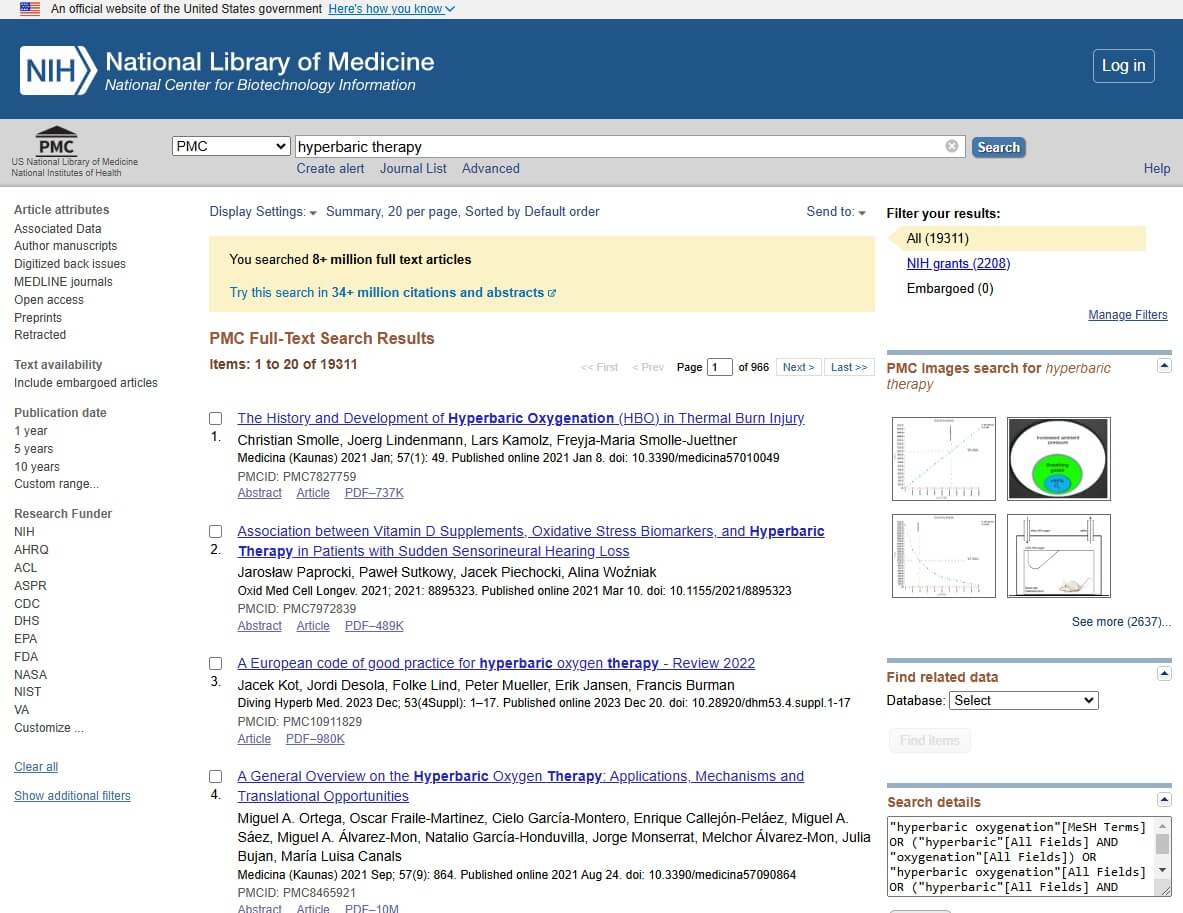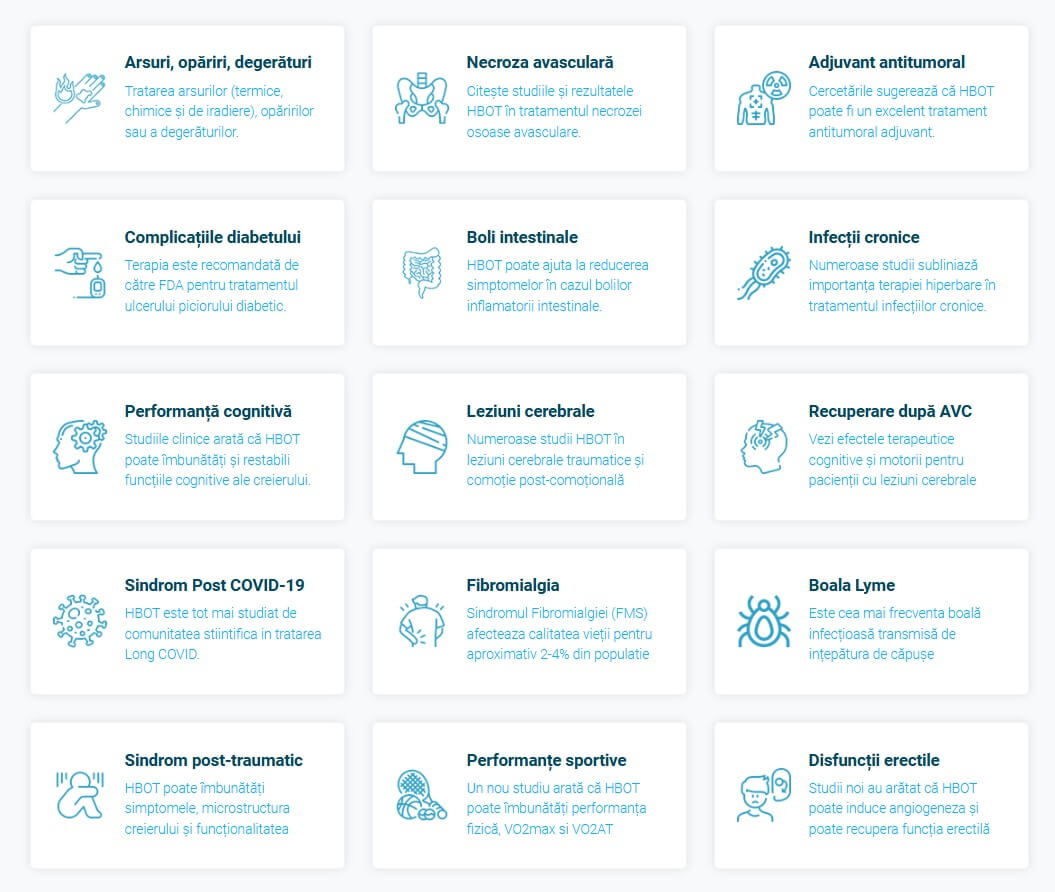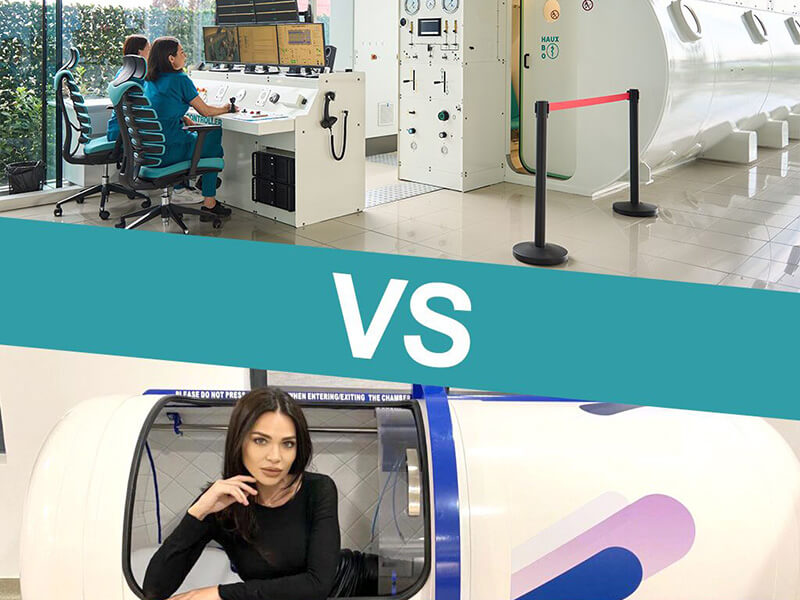
Article reviewed by: Dr. Sturz Ciprian, Dr. Tîlvescu Cătălin and Dr. Alina Vasile
Scientific studies for hyperbaric therapy
There are currently over 17,800 scientific papers, including studies, articles and case studies on hyperbaric therapy, published on PMC. PubMed Central (PMC), is a free digital archive providing access to the full text of scientific articles in the biomedical and life sciences. It is managed by the National Center for Biotechnology Information (NCBI), a division of the National Library of Medicine (NLM) of the US National Institutes of Health (NIH).

Of all the papers on hyperbaric therapy published on PubMed Central, almost half - i.e. 8,500 - were published in the last five years. This trend highlights an increase in interest in hyperbaric therapy in the scientific community recently, indicating a concentration of research and discussion around this topic. At the same time, the fact that there are a significant number of studies published even before this period suggests that hyperbaric therapy is an area with a solid knowledge base that has been explored and developed
In the last year, more than 1,600 scientific papers, articles and case studies on the topic of hyperbaric therapy were published on PubMed Central. To stay up to date with these news, it would be necessary to go through more than 4 such studies every day. Realistically speaking, this pace is hard to sustain for most of us. The specialist doctors at the Hyperbarium clinic constantly dedicate time to stay up-to-date with the latest discoveries and studies. They select the most important and relevant information, which they then group by topics of interest, thus facilitating access to essential knowledge in an efficient and easy-to-understand way in the section of scientific studies on the subject of hyperbarium from the website of the Hyperbarium clinic. Thus, you can rely on their expertise to inform you quickly and accurately, without having to navigate through hundreds of articles on your own.

Currently, the scientific studies section on the Hyperbarium website is organized into 15 distinct categories, each focused on a specific aspect of hyperbaric therapy, to facilitate access to information and provide a more efficient and intuitive:
Burns, scalds, frostbite
A collection of scientific studies demonstrating the effectiveness of hyperbaric therapy in treating burns, whether caused by heat, chemicals or radiation, as well as severe injuries or frostbite.
Aseptic bone necrosis
More and more doctors specializing in bone and joint diseases are recommending hyperbaric therapy to stop bone deterioration without adequate blood circulation and to prevent coxarthrosis, i.e. hip arthritis. In this section you will find a series of scientific studies that propose hyperbaric therapy as an effective solution for femoral head problems, such as aseptic necrosis, especially in the initial stages.
Adjuvant antitumor treatment
A number of scientific studies show that using hyperbaric therapy along with standard cancer treatments, such as radiotherapy or chemotherapy, can bring about significant improvements. These improvements include reducing the risk of death and the likelihood that the disease will come back. Hyperbaric therapy can help fight cancer in several ways: it can improve blood flow to the tumor area, it can slow the growth of cancer cells – especially those suffering from a lack of oxygen – and it can increase the effectiveness of standard therapies. Furthermore, hyperbaric therapy can also alleviate some of the side effects of cancer treatments, such as nausea, vomiting and severe fatigue.
Complications of diabetes
Many recent studies show that hyperbaric therapy helps a lot in the treatment of problems caused by diabetes, such as hard-to-heal foot wounds, nerve problems, vision problems and small blood vessel problems. Even major regulatory bodies such as the FDA (US Food and Drug Administration) and the UHMS (US Hyperbaric and Underwater Medicine Society) recommend this therapy for diabetic foot wounds. They do it because the therapy helps wounds heal faster, greatly reduces the risk of amputation, and makes life better for those affected. What's more, a major study in Portugal found that hyperbaric therapy can improve the way the body of diabetic patients manages sugar, showing that this therapy could also be used to treat type 2 diabetes.
Intestinal inflammatory diseases
Although we are only at the beginning of exploring the effects of hyperbaric therapy on inflammatory bowel diseases, the initial signals are positive. Early studies suggest that this therapy could alleviate symptoms such as pain and inflammation, thus opening up new treatment perspectives for affected patients. Common treatments, which include drugs such as corticosteroids, anti-inflammatories and those that adjust the immune system, can have serious side effects if used for a long time. Instead, hyperbaric therapy, which brings more oxygen to affected areas and reduces inflammation, may be a safer alternative with few side effects.
Chronic infections
A number of studies show that hyperbaric therapy plays an important role in the fight against chronic infections, especially when the infections do not respond well to usual treatments. Chronic infections whose treatments can be improved with hyperbaric therapy include bone problems such as osteomyelitis, inflammation of bones and intervertebral discs, skin and soft tissue infections (such as wounds or burns), inner ear problems, certain lung infections , of the skin (such as abscesses or ulcers) and even Lyme disease.
Improving cognitive performance
A growing number of studies show that regular use of hyperbaric therapy can help preserve and even improve thinking and memory. As the population of the developed world ages, more and more people worry about their physical and mental health. It is estimated that over half of people over the age of 60 experience problems related to declining physical and cognitive functions. Because of this, researchers are working hard to find ways to help improve these functions in older people.
Brain damage
Head injuries are a major cause of death and disability in the developed world, with around a quarter of these cases being so severe that they are considered irreversible, leading to long-term problems with brain function. However, a number of scientific studies show that hyperbaric therapy could play an important role in the recovery of the other 75% of cases. This research suggests that hyperbaric therapy can stimulate the brain's ability to repair and adapt - a phenomenon called neuroplasticity - even in cases of chronic post-concussion syndrome, providing significant improvements in cognitive function.
Recovery after stroke
Numerous recent studies highlight the benefits of hyperbaric oxygen therapy for brain injury recovery. In patients who have suffered a stroke, improvements have been seen in both cognitive and motor functions. Interestingly, hyperbaric therapy has proven effective even long after the initial event, in the chronic phase of recovery. These findings suggest that hyperbaric therapy can stimulate the brain to regain its ability to adapt and repair - called neuroplasticity - even long after the injury has occurred. By doing so, the connection between the structure of the brain and its functions can be restored, opening up new avenues for recovery from brain injuries.
Post COVID-19 Syndrome
A recent study by the Sagol Center for Hyperbaric Medicine and Research in Israel found that hyperbaric therapy can greatly improve thinking, emotional problems, fatigue, sleep and pain in patients dealing with the long-term effects of COVID-19 . Research shows that by improving blood flow to the brain and stimulating neuroplasticity processes in areas of the brain responsible for thinking and emotion, hyperbaric therapy can bring significant relief to people suffering from persistent symptoms after COVID-19. These benefits are seen in mental functions, emotional state, energy level, sleep quality and pain reduction.
Fibromyalgia or fibromyalgia syndrome
Fibromyalgia is a chronic and debilitating condition that affects around 2-4% of the population, being more common in women than men by a ratio of 9 to 1. Although the exact causes of fibromyalgia are still not fully understood understood, part of the problem is thought to be over-sensitization of the central nervous system, leading to unusual brain activity. Recent research shows that hyperbaric therapy can have a positive impact on people with fibromyalgia. This therapy can stimulate the brain's ability to repair and adapt, thus contributing to the normalization of brain activity and the relief of the pain characteristic of this disease.
Lyme disease (borreliosis)
Recent research indicates that hyperbaric therapy may be a promising solution in the treatment of Lyme disease. This condition, well-known for being transmitted by tick bites, often requires long treatments with high-dose antibiotics. Hyperbaric therapy thus emerges as an effective alternative or a valuable complement to traditional treatments, especially for cases that do not respond to standard approaches.
Posttraumatic stress syndrome
Recent studies show that hyperbaric therapy is effective in helping people with PTSD, especially those who have not responded to standard treatments. This success is based on the process of neuroplasticity, leading to improvements in symptoms.
Sports Performance
Recent scientific research highlights the role of hyperbaric therapy in improving sports performance. This method, recognized for its ability to increase oxygenation at the cellular level, helps to optimize the functioning of the mitochondria - the energy centers of the cells. Thus, improvements are observed in the maximum oxygen consumption capacity (VO2 max), in muscle strength and in the efficiency during intense efforts (anaerobic threshold - VO2AT).
Erectile dysfunction
Difficulties in getting or maintaining an erection suitable for sexual activity are often caused by problems with blood circulation in the area. Recent research sheds light on the fact that high-pressure oxygen therapy can stimulate the formation of new blood vessels, a process called angiogenesis. This can help improve erectile function and return to normal functioning.
Conclusion
The field of hyperbaric therapy is rich and diverse, with a wealth of scientific studies attesting to its effectiveness in a wide variety of conditions and ailments. By grouping this research into distinct categories, we want to provide both medical professionals and those interested in the scientific aspects of hyperbaric therapy with a valuable and easily accessible resource. Whether you are a physician looking for evidence to support clinical practice or an individual seeking to better understand the scientific underpinnings of this therapy, we hope this summary of relevant studies will serve as a guide and source of information in exploring the therapeutic potential of the therapy hyperbaric.




